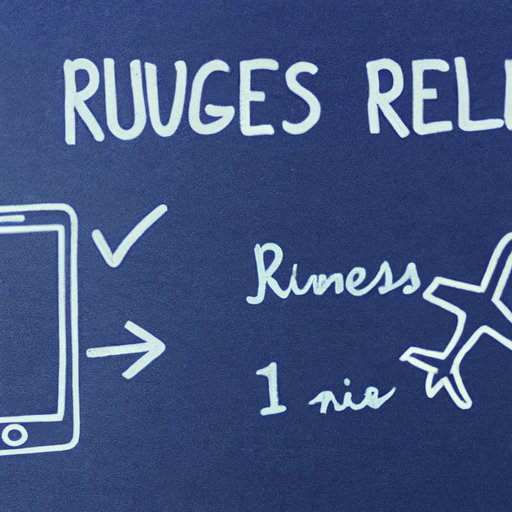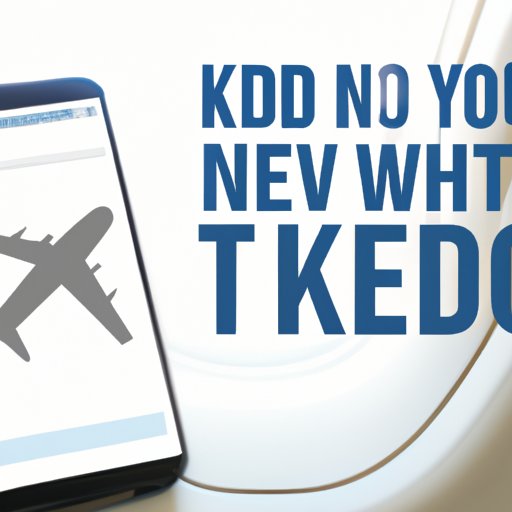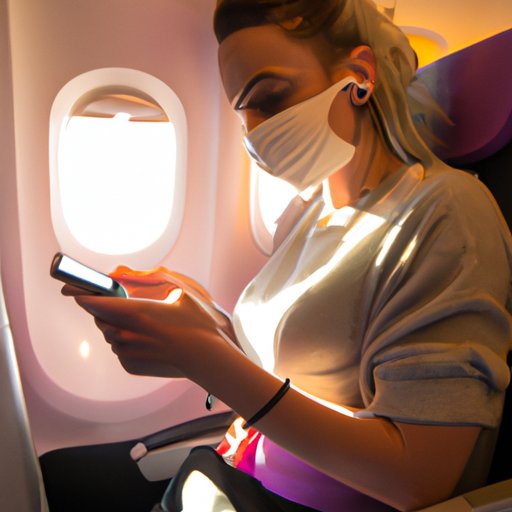Introduction
As our reliance on technology grows, it’s no surprise that texting has become a common way to stay connected even at 30,000 feet. However, many travelers wonder: can you text on a plane? The answer is yes – but there are important rules and regulations to follow, and potential safety concerns to keep in mind. In this article, we’ll explore everything you need to know about texting on a plane, including how to stay connected, navigate regulations, and keep yourself and your fellow passengers safe.

Navigating the Rules: A Guide to Texting on a Plane
The Federal Aviation Administration (FAA) has strict regulations on the use of electronic devices during flights, including texting. In general, passengers are allowed to use their smartphones and other devices in airplane mode during takeoff and landing, and can use their devices for texting and other functions at cruising altitude, as long as airplane mode is still enabled. However, larger devices such as laptops and tablets may need to be stowed during takeoff and landing. It’s important to follow these regulations to ensure a safe and smooth flight.
To text on a plane, you’ll need to have a way to connect to the internet. Many airlines now offer in-flight Wi-Fi, which can be used to send and receive messages through your smartphone or other device. Some airlines also offer text messaging services for a fee. Before your flight, it’s a good idea to research your airline’s policies on in-flight messaging and internet access, and to download any necessary apps or updates to ensure smooth use.
It’s also important to keep in mind that texting can be distracting, and can pose safety concerns for both passengers and crew members. If a flight attendant asks you to pause your texting or other device use, be sure to comply. And be mindful of your surroundings – if you’re seated next to someone who is sleeping or working, for example, it’s important to be respectful and avoid causing unnecessary disruptions.
Keeping Connected at 30,000 Feet: Pros and Cons of In-Flight Texting
While there are rules and potential distractions to be aware of, in-flight texting can also be a valuable way to stay connected during a long flight. Here are some of the pros and cons of in-flight messaging:
- Pros: In-flight texting can help you stay in touch with loved ones or colleagues, even when you’re in the air. It can also be a way to catch up on work emails or other tasks. And for nervous flyers or those who need to stay busy during a flight, texting can be a welcome distraction.
- Cons: Texting can also be a distraction that poses safety concerns. It’s important to be mindful of your surroundings and to avoid causing unnecessary disruptions or distractions for other passengers or flight crew. Additionally, in-flight messaging services may come with extra fees, so it’s important to plan accordingly.
If you’re looking to stay connected while traveling, there are plenty of other options beyond texting. Consider downloading offline content such as ebooks or podcasts, or invest in noise-canceling headphones to help you work or relax without the need for Wi-Fi. And if you do decide to use in-flight messaging, be sure to do so safely and responsibly.

Texting on a Plane – What You Need to Know
So, you’ve decided to text on a plane – what next? Here are some technical aspects to keep in mind:
- If your airline offers in-flight Wi-Fi, you’ll need to purchase a plan to use it. Some airlines offer hourly, daily, or monthly plans, while others may charge by the amount of data used. Be sure to research your airline’s Wi-Fi policies ahead of time.
- To text on a plane via Wi-Fi, you’ll need to connect to the in-flight network and open your messaging app. From there, you can send and receive messages just as you would normally. Keep in mind that messages may be delayed, depending on the strength and speed of the Wi-Fi signal.
- If your airline offers text messaging services, you may need to register or enroll in advance. Be sure to check with your airline for specific instructions.
- If you’re experiencing issues with texting on a plane, there are a few troubleshooting tips to try. First, make sure your device is in airplane mode and that Wi-Fi is enabled. Check that you’re connected to the in-flight network, and try restarting your device if you’re still having trouble.

Staying Safe While Texting on a Plane
While texting on a plane can be convenient and even fun, it’s important to prioritize safety while using electronic devices in the air. Here are some tips for staying safe:
- Always follow the FAA’s regulations on device use during flights. If a flight attendant asks you to pause your device use, be sure to comply.
- Be mindful of your surroundings and avoid causing unnecessary distractions for other passengers or flight crew.
- If you’re using in-flight Wi-Fi, be aware that messages may be delayed or take longer to send due to the speed and strength of the signal. Allow extra time for sending and receiving messages, and be patient if there’s a delay.
- If you’re concerned about phone bills or extra fees for in-flight texting, consider alternative options such as messaging apps that use Wi-Fi.
Worried About Phone Bills? Here’s How to Text on a Plane Without Paying Extra
If you’re concerned about racking up phone bills while texting on a plane, there are a few ways to avoid extra charges. Here are some options to consider:
- Use in-flight Wi-Fi, which typically offers messaging services as part of a paid plan. Be sure to research your airline’s Wi-Fi policies and pricing ahead of time.
- Use messaging apps such as WhatsApp or Facebook Messenger that use Wi-Fi rather than cellular data. Be sure to download the apps and set them up before your flight – and make sure your recipients have the same app for seamless communication.
- If you’re texting a fellow passenger on the same flight, consider using your device’s Bluetooth or AirDrop features to send messages without the need for Wi-Fi or cellular data.
Tech Tips: The Best Apps for Texting on a Plane
If you’re looking to up your in-flight messaging game, there are a variety of apps to choose from. Here are some top picks:
- iMessage: If you’re an Apple user, iMessage is built right into your device and can be used for texting without the need for Wi-Fi or cellular data.
- WhatsApp: This popular app offers free messaging and voice calls over Wi-Fi, making it a great option for in-flight communication.
- Viber: In addition to messaging and voice calls, Viber offers fun extras like stickers and GIFs to spice up your conversations.
- Facebook Messenger: Like WhatsApp, this app offers free messaging and voice calls over Wi-Fi, as well as fun features like emojis and GIFs.
- WeChat: This app offers a variety of features beyond messaging, including social networking and mobile payment options.
Conclusion
In short, yes – you can text on a plane. However, there are important rules, regulations, and safety concerns to keep in mind. If you’re planning to text in-flight, be sure to research your airline’s policies on Wi-Fi and messaging services, download any necessary apps or updates, and prioritize safety and consideration for fellow passengers and crew members. And remember – texting is just one of many ways to stay connected while traveling. Consider offline resources, in-flight entertainment, or other activities to make the most of your time in the air.
